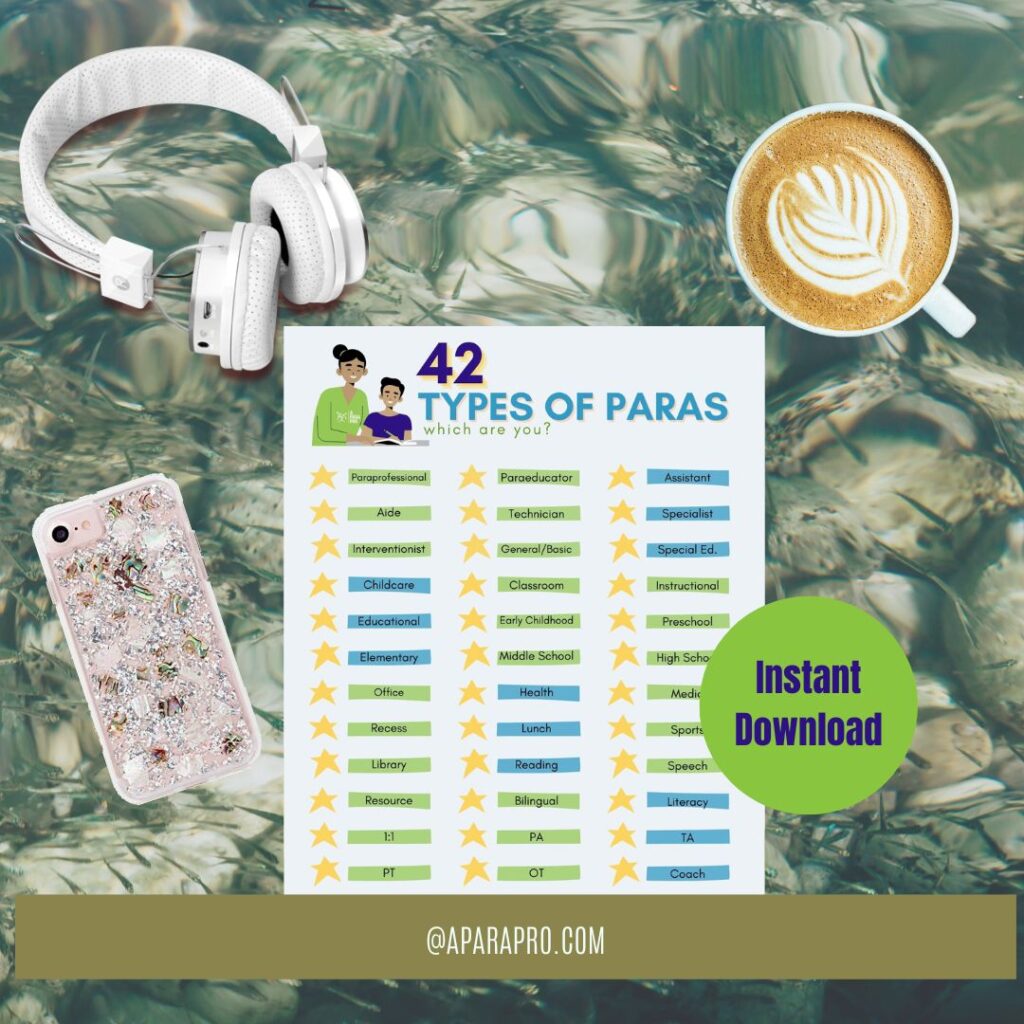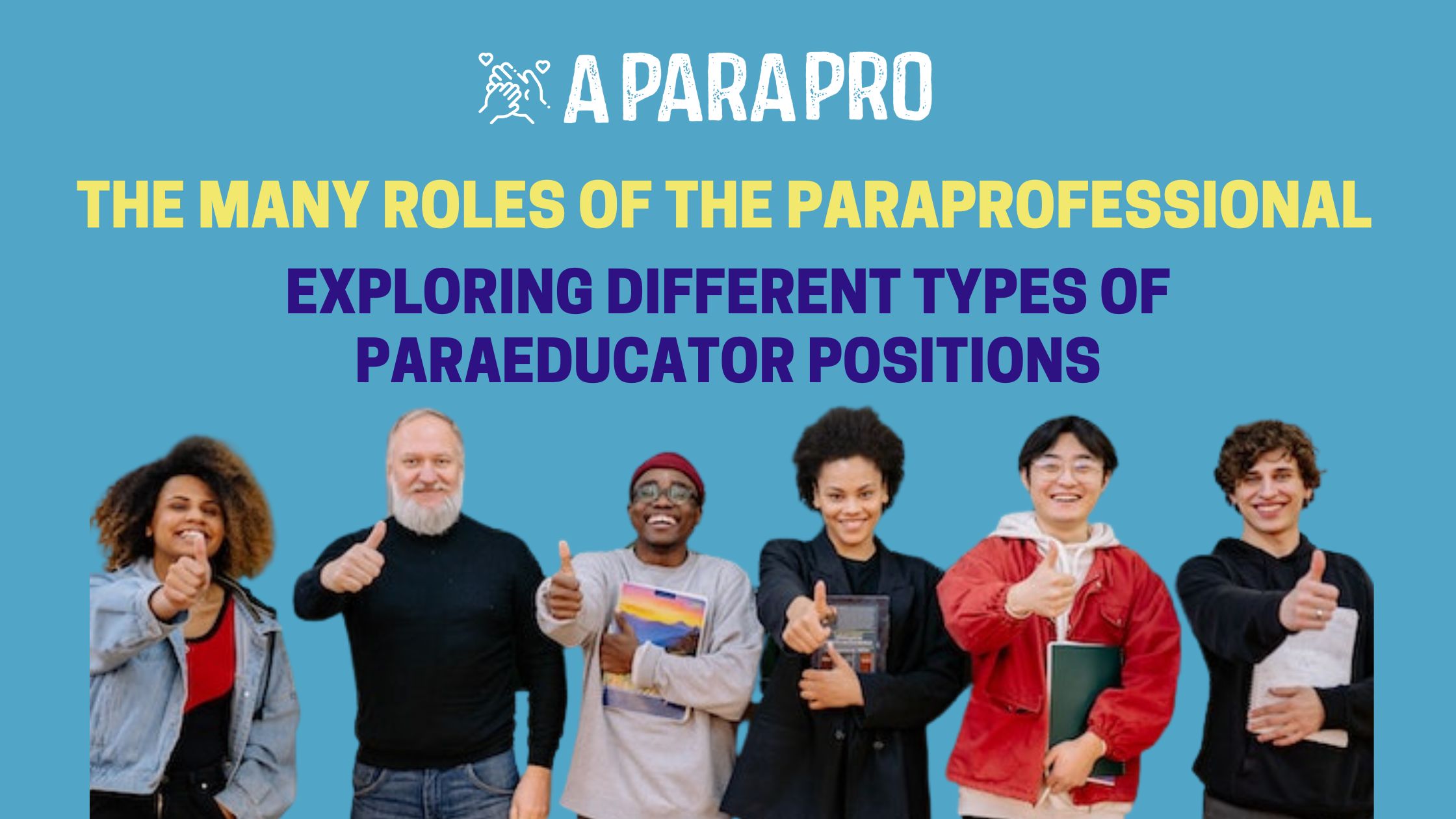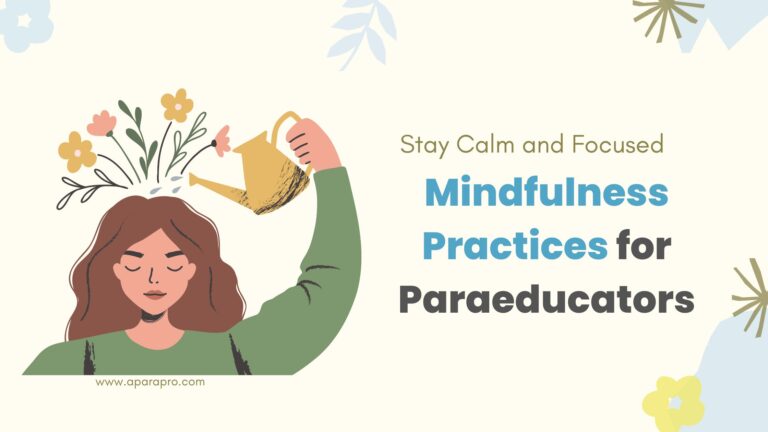The Many Roles of the Paraprofessional: Exploring Different Types of Paras
Welcome to my blog post about the different types of paras, such as paramedics, paralegals, and my favorite paraeducators! In this post, I'll be focusing specifically on paraeducators and taking a closer look at the various roles they play in our society.

Whether you're interested in becoming a paraeducator yourself or just curious to learn more about this profession, I'm here to provide you with helpful and friendly information to get you started. So let's dive right in!
Different Types of Paras
From healthcare to law and education, paraprofessionals are playing an increasingly important role in a variety of industries.
Para-Medic
Paramedics are the first responders to arrive on the scene. They are responsible for providing the best possible medical care in the field to patients who are in crisis. They work in various team settings, including hospitals, clinics, and emergency rooms.
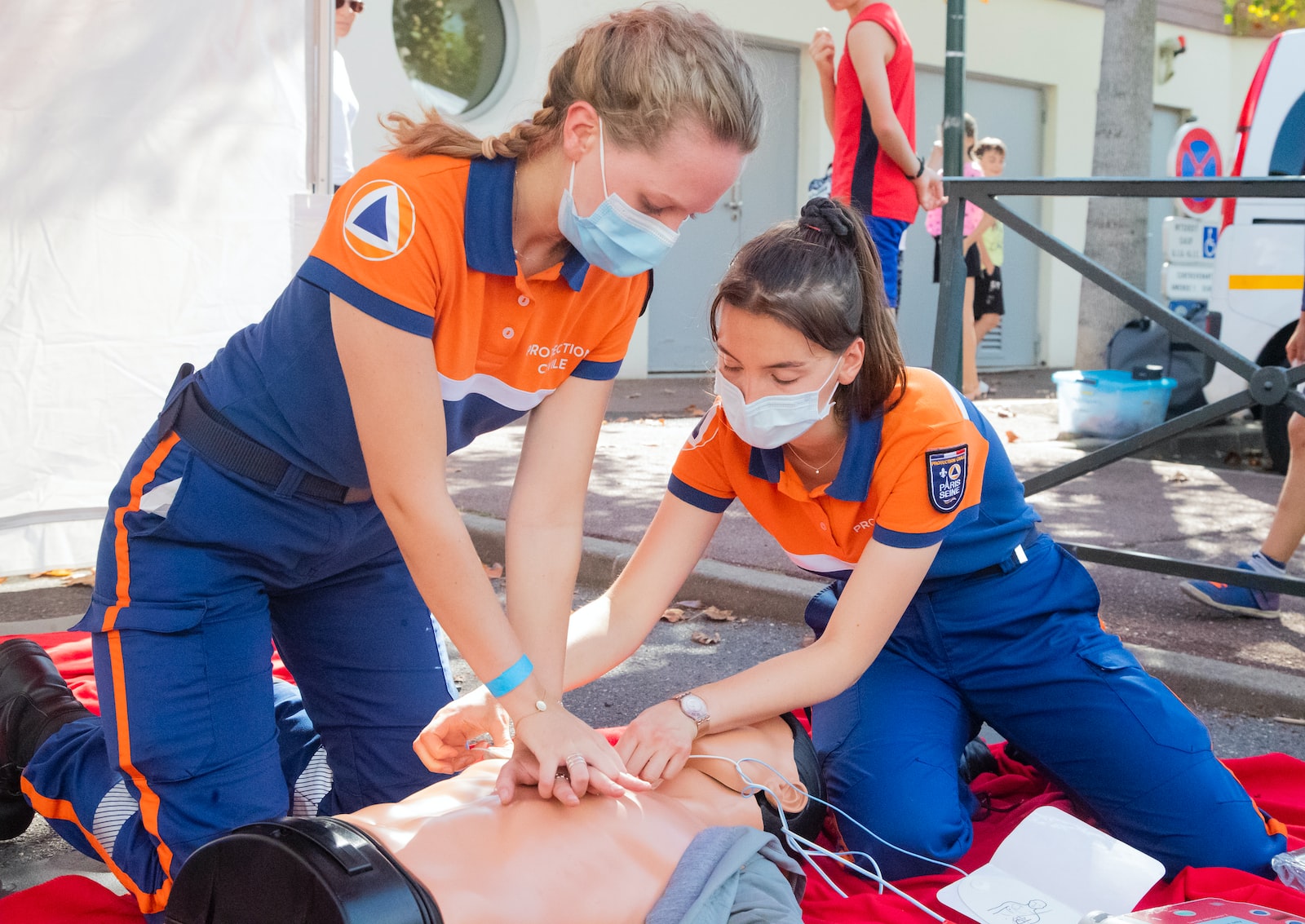
Paramedics are typically trained in basic life support, including cardiopulmonary resuscitation (CPR) and first aid. They are also skilled in providing medical care for patients with injuries.
Paramedics are in high demand and often have to compete for jobs with other first responders, such as firefighters and police officers. However, the position is highly rewarding and can provide a career path that leads to a career in medicine. If I wasn't a paraeducator I might consider being a paramedic, I just love watching Night Watch, I'm literally watching it as I'm drafting this.
Para Legal
A paralegal is a legal assistant who assists attorneys with legal paperwork such as legal research, document preparation, and creating pleadings, and other legal documents.
They also may be responsible for court appearances. They may also help clients with their legal proceedings, such as filing lawsuits or resolving disputes.

A paralegal job requires a degree in law, experience working with legal documents, and excellent typing and computer skills. Many paralegal positions also require a license to practice law.
What is a Para in Education?
There are many types of paras in the education field. A para in education is a support worker in the school system. They help students with IEPs or 504s and offer assistance with classwork and other activities. Paraeducators are also responsible for enforcing school rules and ensuring the safety of students.
Paraeducator
A Paraeducator is responsible for providing instruction and support to students with disabilities but also those that have learning difficulties. Paras must be able to handle various situations that may arise, and be able to keep the class on track.

They must also be able to provide assistance to the teacher when needed. Like providing instructional support in the classroom, helping to manage student behavior, and maintaining records of student progress.
A paraeducator job requires strong communication, problem-solving, and organizational skills. They must also be able to work with a variety of students and be aware of their individual needs. Additionally, they must be able to ensure students' safety and respond quickly to any emergencies that may arise.
Different Types of Paras in Education?
Welcome to the world of educational paras! Knowing various types of paras in education can be very useful in helping you make the right decisions for your paraeducator job. In this blog, we will explore the different types of paraeducators that are available to help students learn, grow, and thrive in their educational pursuits. Through this blog, we hope to provide an understanding of the different types of para positions available and how they can benefit your para job journey.
What's the Difference Between a Paraprofessional, Paraeducator, Aide, Assistant, and Sub-Para?
Are you confused by the differences between a paraprofessional, paraeducator, aide, assistant, and a sub para? Don’t worry, you’re not alone! It can be hard to keep all these roles straight, but understanding the differences between them can help make sure that you’re getting the best possible support from your school or educational setting.

Paraprofessional
A paraprofessional is a term that is used to describe someone who works under the supervision of a professional in any given field. For example, in the medical profession, you would find paramedics; in the legal profession, you would find paralegals; and in the education field, you would find paraeducators.
Paraeducator (also referred to as Teacher's Aide and Teaching Assistant)
Paraeducators provide direct support to students with special needs, as well as to the teachers in the classroom. They may assist with individualized instruction, serve as a classroom assistant, or provide support to small groups. Paraeducators may also provide technical assistance with the use of technology and specialized equipment. They are an integral part of providing educational services, as they bridge the gap between teaching staff and students. Paraeducators are usually found in primary and secondary schools, assisting teachers with classroom management, providing individualized instruction, and helping with the overall instructional program. In the end, the major difference between paraeducators, aides, and assistants is that paraeducators are trained to work in special education while aides and assistants perform general ed tasks. But for the most part, the terms are used synonymously.
Sub-Para
We'll go a little deeper on sub-paras later but for now… A sub-para is a paraprofessional who provides short-term assistance to a teacher in the classroom. Sub-paras may are usually hired to help as a last resort when there is no other qualified personnel available or to provide additional support for a teacher who may have a large class size. Sub paras are different from permanent aides in that they are not assigned to a particular classroom and may not have extensive classroom experience.
What are the Different Types of Para Educator Levels?
At the heart of paraeducator roles are two main levels: Level 1 and Level 2.
But what is the difference between paraeducators 1 and 2?
Each level has its own specific requirements and duties. Let’s take a closer look at the differences between the two.
Level 1
Level 1 Paraeducators are typically part-time employees who provide general assistance in a teaching or educational setting. They may be responsible for helping the teacher with classroom activities, managing the classroom environment, and providing support to students. They often do not require formal education beyond a high school diploma or GED, although some employers may require additional qualifications.
Level 2
Level 2 Paraeducators are usually full-time employees with more responsibility in the classroom. They may be responsible for more complex tasks such as tutoring, providing specialized instruction, and developing instructional materials. Level 2 Paraeducators may also be expected to have additional qualifications such as a college degree, professional certification, or experience in a related field.

So, there you have it – the two main levels of paraeducators. If you’re looking to join the ranks of these invaluable professionals, make sure to check out the qualifications in your state so you can be sure you meet the requirements. And don’t forget – you’ll need specialized training in order to become a Level 2 paraeducator.
What Does a One-on-One Para Do?
A 1:1 para is a trained professional who works one-on-one with an individual to provide assistance and support in various areas. The 1:1 para's role is highly individualized and depends on the person they are working with. Generally, it includes providing direct support in various activities, helping the individual understand complex concepts and ideas, providing emotional and social support, helping to develop and practice skills, modeling appropriate behavior, and providing feedback. This can mean anything from helping a student in a classroom with their schoolwork to providing support to someone with a disability to participate in activities that they may otherwise not be able to do. They are also responsible for supervising and making sure that their student is safe and secure.
List of 1:1 Paraeducator Duties
- Helping with academic tasks, such as reading, writing, and math
- Assisting with therapeutic activities, such as art therapy, music therapy, and physical therapy
- Providing behavior management support
- Assisting with daily living activities, such as hygiene, eating, and dressing
- Developing and implementing individualized learning plans
List of Different Types of Paras Found in Education
Whether you’re an experienced educator or just starting out, there are plenty of options available! From general education to special education, the list of para jobs in education is vast and diverse. From classroom support to one-on-one time with students, there’s something for everyone. Let’s explore a few of the most popular para jobs in education and see what fits you best. With a friendly and helpful attitude, you’ll be sure to find the perfect job for your skills and interests.
7 Paraeductor Jobs in Education
While most paraeducators are employed in special education settings, there are a number of other job opportunities in the educational field for those looking to pursue a career as a paraeducator. Here is a list of seven paraeducator positions not in special education:
- Classroom Aide: Classroom aides provide support to teachers in the classroom. They may be responsible for aiding in instruction, monitoring the students, providing help with classroom management, and providing general support to the students.
- Office Aide: Office aides are responsible for organizing student records, filing, answering phones, and other clerical duties.
- Tutor: Tutors specialize in providing extra instruction to students in a particular subject area. They work closely with teachers and students to ensure that students understand the material and are able to apply it in their own studies.
- Library Aide: Library aides help with the organization and maintenance of the library, as well as other library-related tasks such as giving guidance to patrons and preparing materials for circulation.
- Cafeteria Aide: Cafeteria aides help to ensure that the cafeteria runs efficiently, stocking shelves, checking supplies, and helping to prepare meals.
- Computer Lab Aide: Computer lab aides help teachers to prepare and present lessons in the computer lab. They may help set up the computers, assist in troubleshooting and repair, and provide guidance to students.
- Technology Aide: Technology aides are responsible for helping teachers to use technology in the classroom. They may help to set up and maintain the technology, as well as troubleshoot any problems.
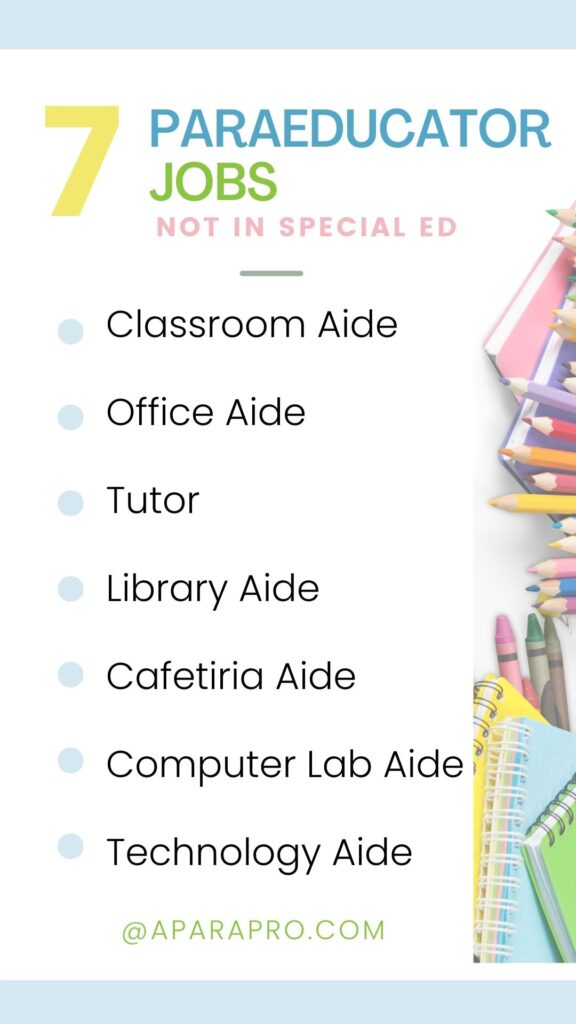
These are just seven of the many paraeducator positions available in the educational field. If you’re looking for a rewarding career in which you can make a real difference in the lives of students, then a paraeducator position might be the perfect opportunity for you!
7 Different Types of Paras in Special Ed.
Special ed paraeducators provide invaluable support and guidance to students with special needs in the classroom. You might be wondering, what kinds of special ed paraeducator jobs are out there? Well, we’ve got you covered! Below, we’ve put together a list of seven special ed paraeducator jobs, so you can find the one that’s right for you.
- Behavior Interventionist: Behavior interventionists provide direct instruction to students with challenging behaviors, using evidence-based strategies. They work with the student’s teachers and family to develop behavior plans and provide support to help the student become more successful in the classroom.
- Instructional Aide: Instructional aides help teachers and students in the classroom by providing assistance with instruction, reinforcing concepts and skills, providing individualized instruction, and more.
- Special Ed Classroom Aide: Special ed classroom aides assist teachers in the classroom by providing support to students with disabilities. They may help with classroom management, instructional activities, and personal care needs.
- Occupational Therapist Assistant: Occupational therapist assistants help students with disabilities learn and practice skills that enable them to better participate in daily activities and routines. They may help with communication, self-care, sensory processing, and more.
- Speech Language Pathology Assistant: Speech-language pathology assistants help students with communication-related disabilities by providing support with speech, language, and other communication needs.
- Assistive Technology Specialist: For some students with disabilities, assistive technology can be an important part of their education. As a special education paraeducator, you might be responsible for teaching students how to use assistive technology, such as voice recognition software, and helping them to understand how to use the technology to their advantage.
- Transition Coach: Transition coaches help students with disabilities transition from high school to college, work, or other post-secondary destinations. They provide support with career exploration, job readiness, and other transition-related services.
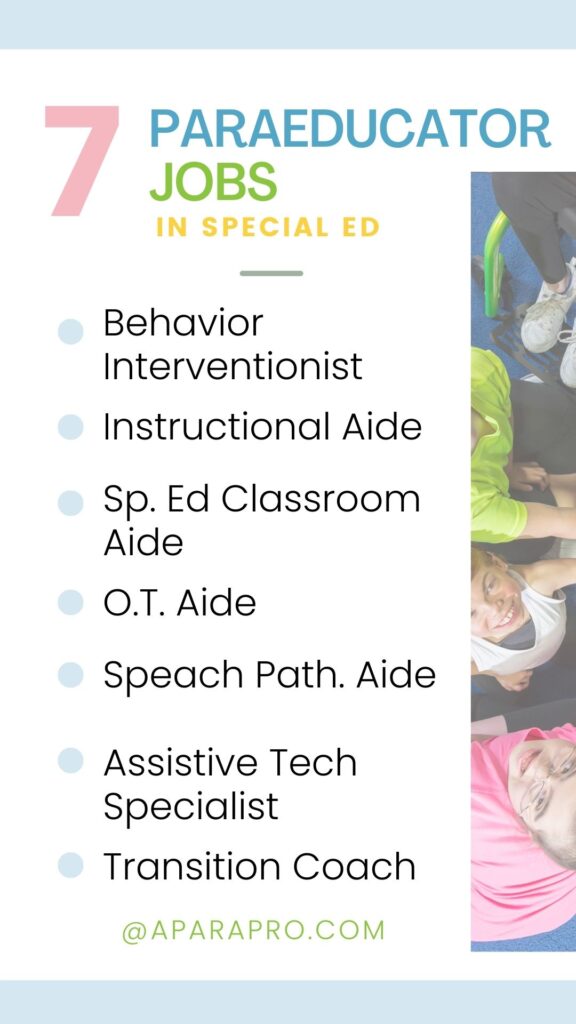
These are just a few of the special education paraeducator jobs that you might find interesting. If you’re looking for a job that’s both rewarding and fulfilling, consider becoming a special education paraeducator. No matter what job you take on, you can make a major difference in the lives of special education students.
What is a Substitute Paraeducator?
Substitute paraeducators often work under the supervision of a certified teacher to provide the support that meets the needs of the student. Substitute paraeducators are often employed on a temporary, part-time basis. This is beneficial for school districts, as it helps them manage their staffing needs more efficiently. However, it can also be beneficial for the substitute paraeducator, as it gives them the flexibility to work when and where they need to. Substitute paraeducators are often responsible for helping students understand their lesson plans, creating a positive and supportive learning environment, and monitoring student progress. They may also be involved in providing instruction, helping students complete assignments, and providing instruction in the use of assistive technology.
Can a Sub-Para be a Sub-Teacher?
The short answer is yes, but with some important caveats. While a substitute paraeducator can take on the role of a substitute teacher, they must be properly trained and certified to do so (i.e. have a bachelor's degree) It’s important to note that substitute paraeducators are not certified or qualified to teach in the same way as full-time teachers. Therefore, they must be carefully supervised and their instruction must be closely monitored. They must also be familiar with the school’s policies and procedures, as well as the curriculum being taught.
FAQ
Being a paraeducator can be a difficult job, but it is also incredibly rewarding. Paraeducators provide vital support to teachers and students in the classroom and help ensure that all students are receiving the best education possible. The job of a paraeducator is both challenging and demanding. A successful paraeducator must be organized, patient, and have a strong understanding of teaching strategies and classroom dynamics. They must be able to effectively communicate with students, parents, and teachers to ensure an effective learning environment. Additionally, paraeducators must be able to manage a variety of responsibilities and tasks without becoming overwhelmed.
The most important quality of a good paraeducator is their ability to form positive relationships with students and colleagues. Paraeducators must be able to listen to and understand student needs and have the patience and empathy to provide support and guidance. Paraeducators should also be able to establish a sense of trust with students and parents, as well as act as positive role models. Paraeducators must also be knowledgeable about the curriculum and teaching strategies. They should be able to take direction from the teacher and be able to follow through with the tasks assigned to them. They should also be able to identify areas of the curriculum where students may need additional support, and provide appropriate interventions. Paraeducators should also be able to assess student progress and make informed decisions about classroom management and instructional strategies.
1. Get Your License
2. Apply for Jobs
3. Maintain Certification
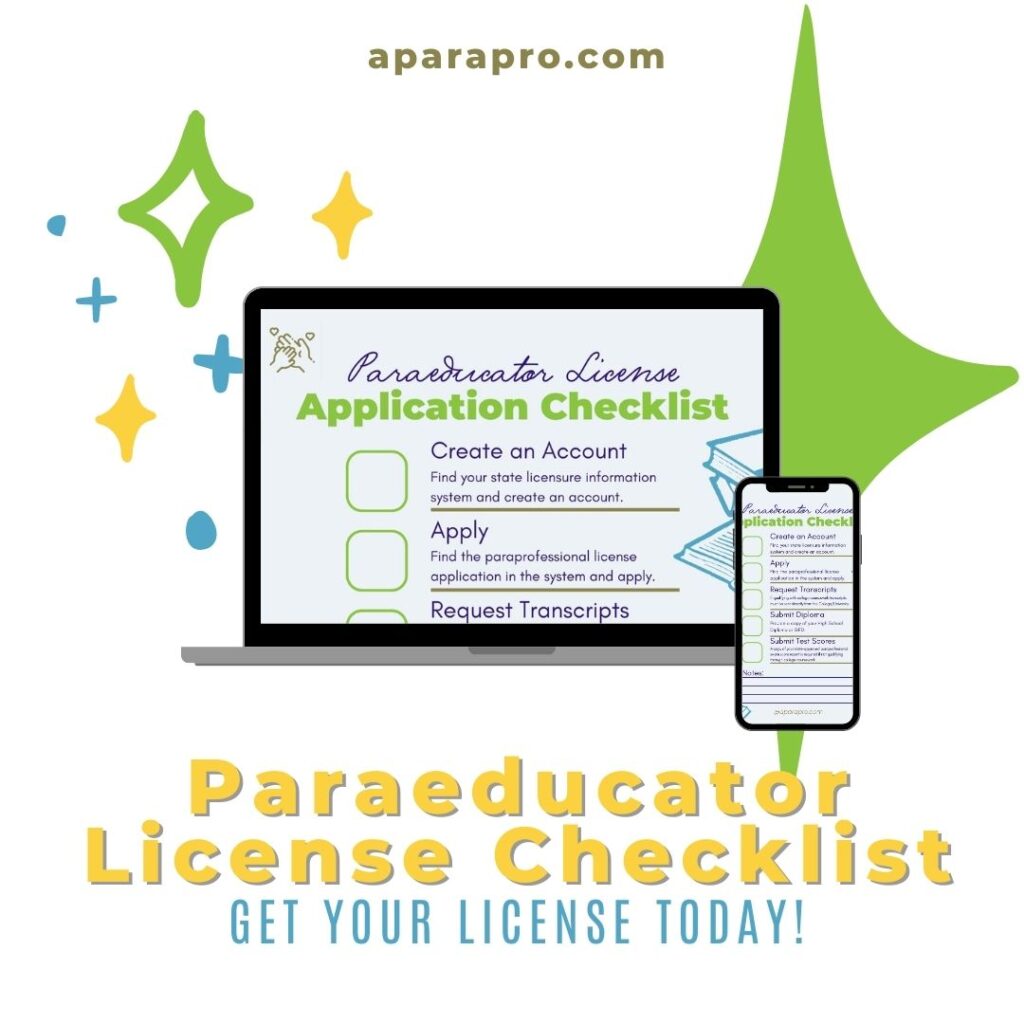
Conclusion
In conclusion, it is clear that there are many different types of paraprofessionals across various fields and industries. From medical to legal and especially in education, paraprofessionals play an invaluable role in providing support to students and teachers alike. As we have seen, there are different paraeducator positions for regular education and special education, as well as sub-paras. Being a paraeducator is not an easy job, and requires a certain level of skill and dedication. However, by understanding the different types of paraprofessionals, and the roles they play, we can make sure they are supported in the best possible way. So why not take advantage of my extensive list of para and find out more about the different types of paras out there?
